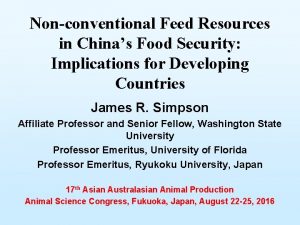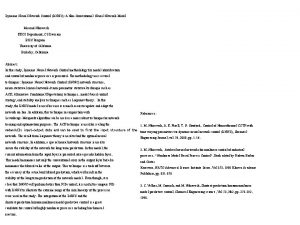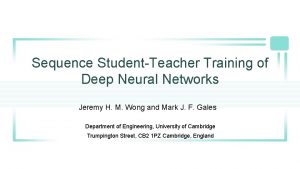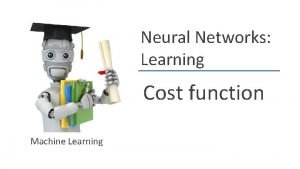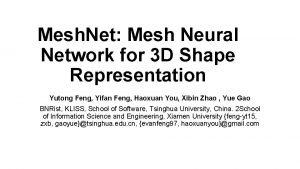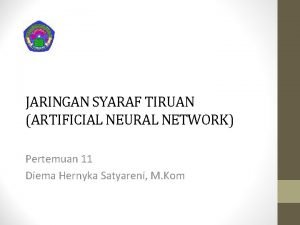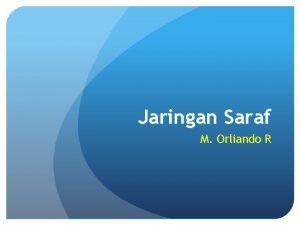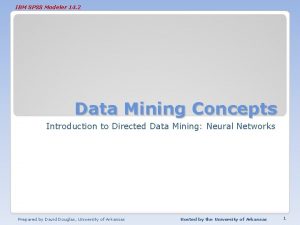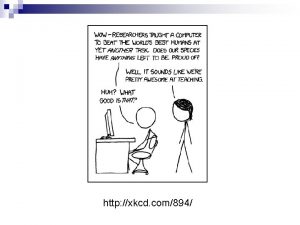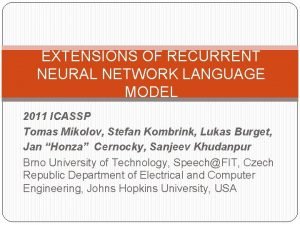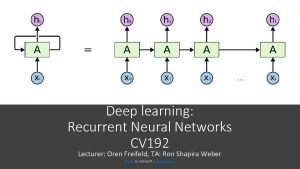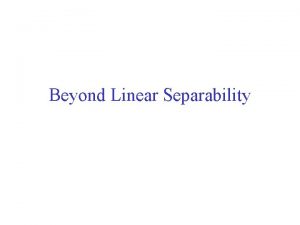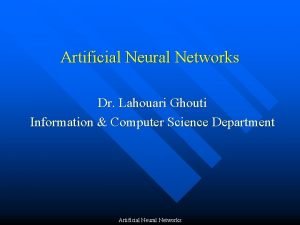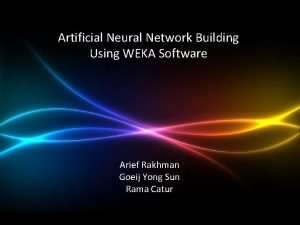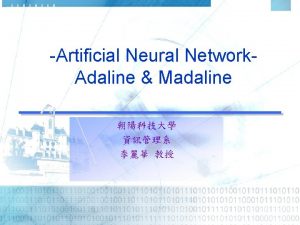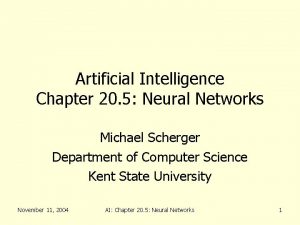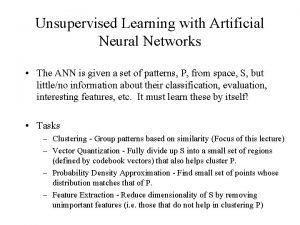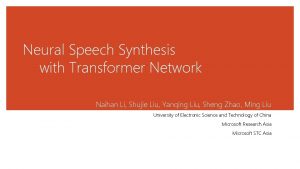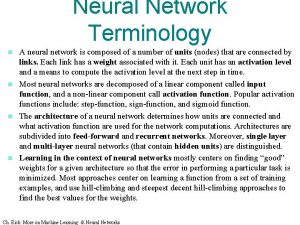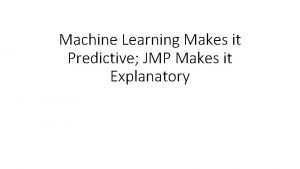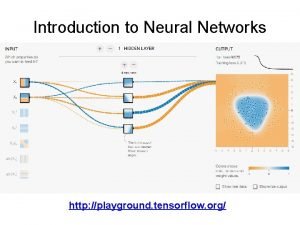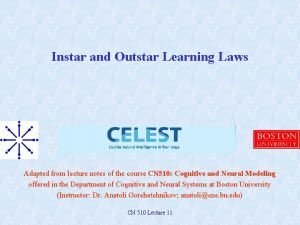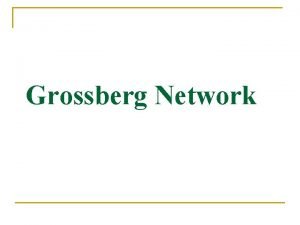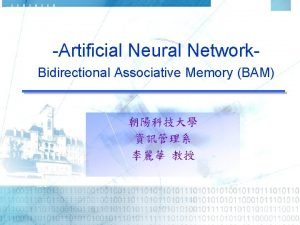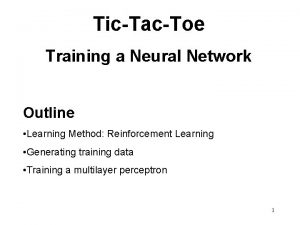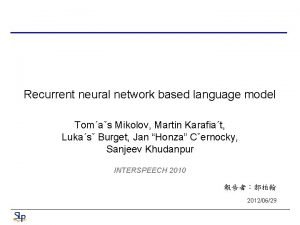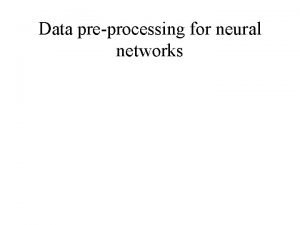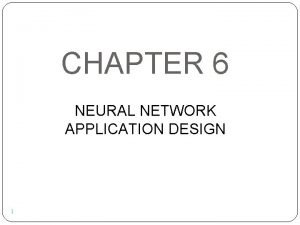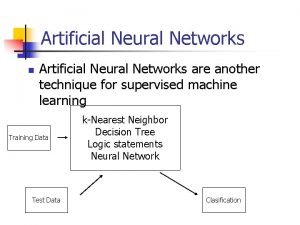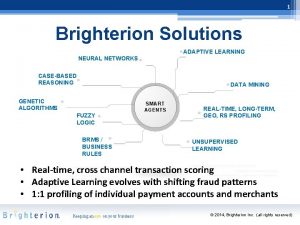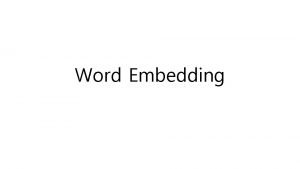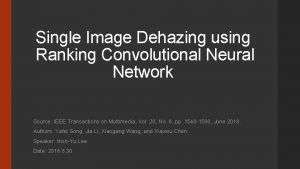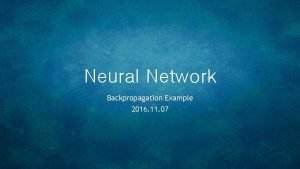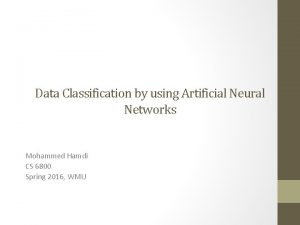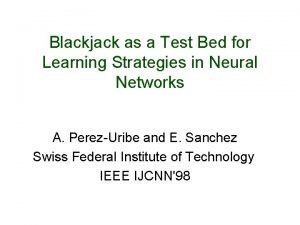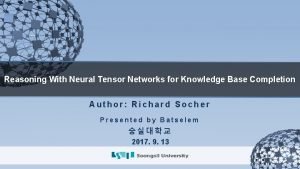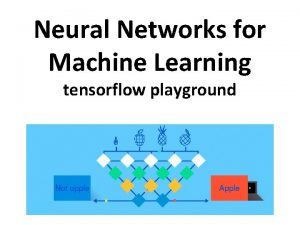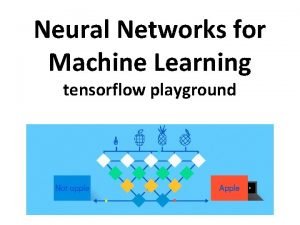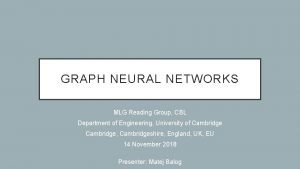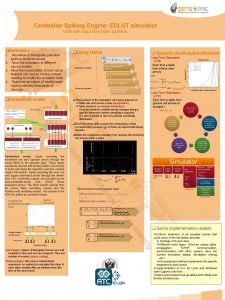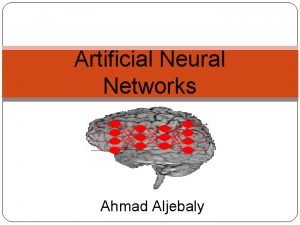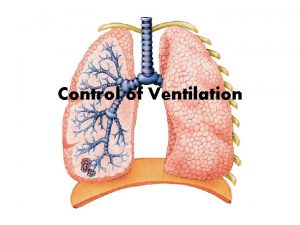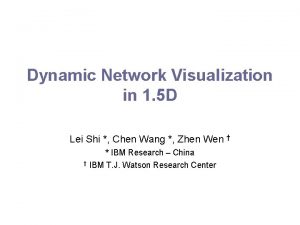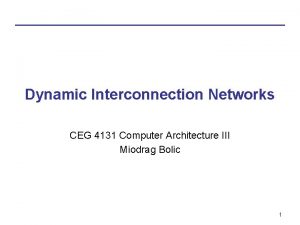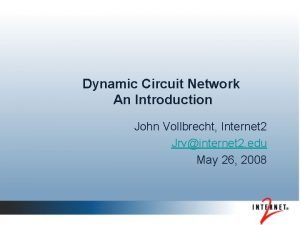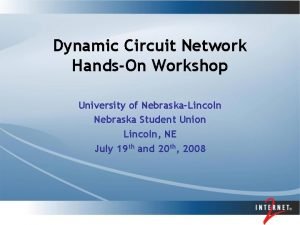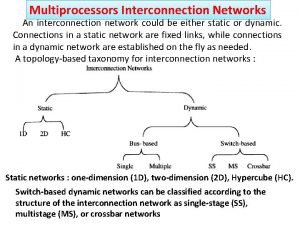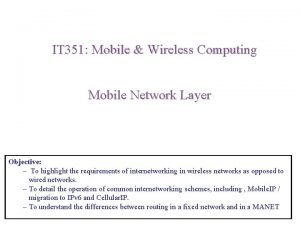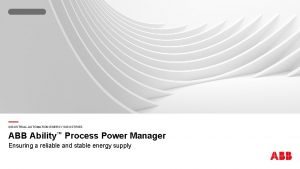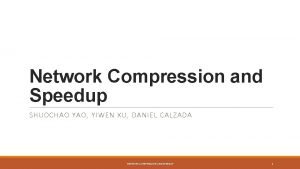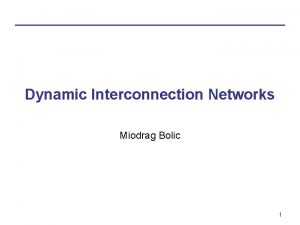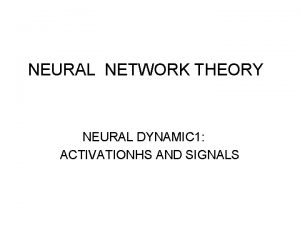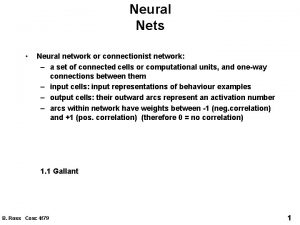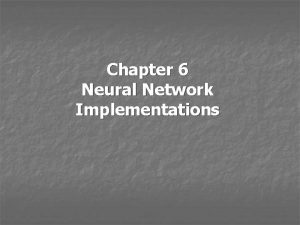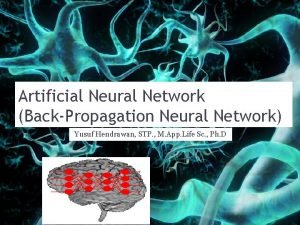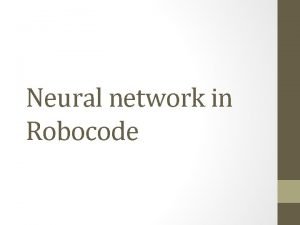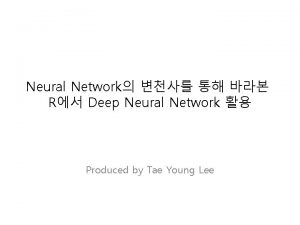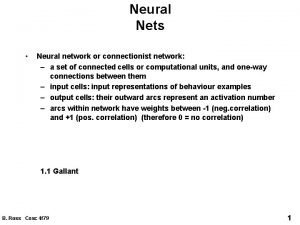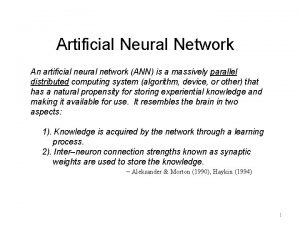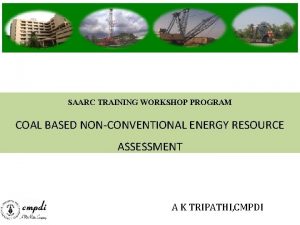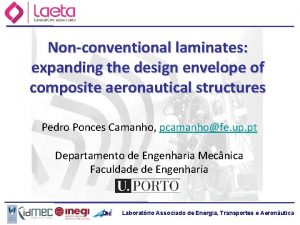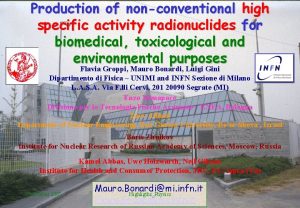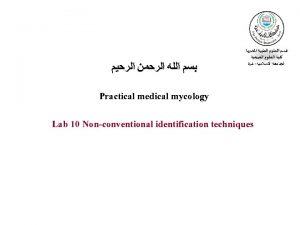Dynamic Neural Network Control DNNC A NonConventional Neural





























































- Slides: 61

Dynamic Neural Network Control (DNNC): A Non-Conventional Neural Network Model Masoud Nikravesh EECS Department, CS Division BISC Program University of California Berkeley, California Abstract: In this study, Dynamic Neural Network Control methodology for model identification and control of nonlinear processes is presented. The methodology uses several techniques: Dynamic Neural Network Control (DNNC) network structure, neuro-statistical (neural network & non-parametric statistical technique such as ACE; Alternative Conditional Expectation) techniques, model-based control strategy, and stability analysis techniques such as Liapunov theory. In this study, the DNNC model is used because it is much easier to update and adapt the network on-line. In addition, this technique in conjunction with References: Levenberge-Marquardt algorithm can be used as a more robust technique for network training and optimization purposes. The ACE technique is used for scaling the 1. M. Nikravesh, A. E. Farell, T. G. Stanford, Control of Nonisothermal CSTR with network�s input-output data and can be used to find the input structure of the time varying parameters via dynamic neural nework control (DNNC), Chemical network. The result from Liapunov theory is used to find the optimal neural Engineering Journal, vol. 76, 2000, pp. 1 -16. network structure. In addition, a special neural network structure is used to insure the stability of the network for long-term prediction. In this model, the 2. M. Nikravesh, Artificial neural networks for nonlinear control of industrial current information from the input layer is presented into a pseudo hidden layer. processes, " Nonlinear Model Based Process Control", Book edited by Ridvan Berber This model minimizes not only the conventional error in the output layer but also and Costas minimizes the filtered value of the output. This technique is a tradeoff between Karavaris, NATO Advanced Science Institute Series, Vol 353, 1998 Kluwer Academic the accuracy of the actual and filtered prediction, which will result in the Publishers, pp. 831 -870 stability of the long-term prediction of the network model. Even though, it is clear that DNNC will perform better than PID control, it is useful to compare PID 3. S. Valluri, M. Soroush, and M. Nikravesh, Shortest-prediction-horizon nonlinear with DNNC to illustrate the extreme range of the non linearity of the processes model-predictive control, Chemical Engineering science, Vol 53, No 2, pp. 273 -292, were used in this study. The integration of the DNNC and the 1998. shortest-prediction-horizon nonlinear model-predictive control is a great candidate for control of highly nonlinear processes including biochemical reactors.

Dynamic Neural Network Control (DNNC): A Non-Conventional Neural Network Model Masoud Nikravesh EECS Department, CS Division BISC Program University of California Berkeley, California

Dynamic Neural Network Control (DNNC) 1. Introduction 2. Theory 3. Applications and Results 4. Conclusions 5. Future Works


IMC d ysp + e’ w Q u y + P + d P y +

Modified IMC, Zheng ysp + e’ Q 1 w 1 + u w y + P + - d d et al. (1994) w 2 Q 2 P y To address integral windup. +

Non-linear model state-feedback control structure d ysp + e’ d w’ 1 Q’ 1 + w’ 2 w u y + P Q’ 2 x=f(x)+g(x) u x h(x(t- ) y +

On-Line Adaptation


Controller CA CA Trajectory qc CA Setpoint Model Filter

Model Predictive Control Y ai Time i

k = discrete time y(k) = model output u(k) = change in the input (manipulated variable) defined as u(k)- u(k-1) d(k) = unmodelled disturbance effects on the output ai = unit step response coefficients N = number of time intervals needed to describe the process dynamics (Note: ) ym(k) = current feedback measurement y* (k+j) = predicted output at k+j due to input moves up to k. In the absence of any additional information, it is assumed that


The Backpropagation Neural Network

Comparing DMC with the neural network, the following analogy may be drawn,

The DNNC Process Model

The DNNC Process Model

State-Space Representation of DNNC

State-Space Representation of DNNC

State-Space Representation of DNNC

Stability of the DNNC Process Model

DNNC Controller

Stability of the DNNC Process Model

Stability of the DNNC Process Model

Extension of the DNNC Model to the MIMO Case in IMC Framework

Neuro-Statistical Model



Upper Mean Actual MPV Lower




Typical multi-layer DNNC process model.

Alternative Conditional Expectation X (X) Y (Y)

NN Prediction No. Epochs: 200 No. Hidden Nodes: 10 No. Epochs: 5 No. Hidden Nodes: 1


Typical multi-layer DNNC process model.

Controller CA CA Trajectory qc CA Setpoint Model Filter

Process Model c (t)= exp ( - t ). h(t) c(t) CA qc q CAf Tf Tcf : : : : : Fouling coefficient Deactivation coefficient effluent concentration, the controlled variable coolant flow rate, the manipulated variable feed flow rate, disturbance feed concentration feed temperatures coolant inlet temperature


















Conclusions • The DNNC strategy differs from previous neural network controllers because the network structure is very simple, having limited nodes in the input and hidden layers. • As a result of its simplicity, the DNNC design and implementation are easier than other control strategies such as conventional and hybrid neural networks. • In addition to offering a better initialization of network weights, the inverse of the process is exact and does not involve approximation error. • DNNC’s ability to model nonlinear process behavior does not appear to suffer as a result of its simplicity. • For the nonlinear, time varying case, the performance of DNNC was compared to the PID control strategy. • In comparison with PID control, DNNC showed significant improvement with faster response time toward the setpoint for the servo problem. • The DNNC strategy is also able to reject unmodeled disturbances more effectively. • DNNC showed excellent performance in controlling the complex processes in the region where the PID controller failed. • It has been shown that the DNNC controller strategy is robust enough to perform well over a wide range of operating conditions.

IMC d ysp + e’ w Q u y + P + d P y +

Modified IMC, Zheng ysp + e’ Q 1 w 1 + u w y + P + - d d et al. (1994) w 2 Q 2 P y To address integral windup. +

Non-linear model state-feedback control structure d ysp + e’ d w’ 1 Q’ 1 + w’ 2 w u y + P Q’ 2 x=f(x)+g(x) u x h(x(t- ) y +

Future Works • The integration of the DNNC and the shortest-prediction-horizon nonlinear model-predictive • No assumption regarding the uncertainty in input and output • Use of fuzzy logic techniques.
 Nonconventional feed
Nonconventional feed Dnnc
Dnnc Dynamic dynamic - bloom
Dynamic dynamic - bloom Ib psychology
Ib psychology Least mean square algorithm in neural network
Least mean square algorithm in neural network Student teacher deep learning
Student teacher deep learning Cost function deep learning
Cost function deep learning Tlu in neural network
Tlu in neural network Meshnet: mesh neural network for 3d shape representation
Meshnet: mesh neural network for 3d shape representation Pengertian artificial neural network
Pengertian artificial neural network Neural network in r
Neural network in r Matlab neural network toolbox
Matlab neural network toolbox Spss neural network
Spss neural network Xkcd neural network
Xkcd neural network Extensions of recurrent neural network language model
Extensions of recurrent neural network language model Lstm colah
Lstm colah Cnn ppt for image classification
Cnn ppt for image classification Limitations of perceptron:
Limitations of perceptron: Artificial neural network in data mining
Artificial neural network in data mining Least mean square algorithm in neural network
Least mean square algorithm in neural network Weka neural network
Weka neural network Difference between adaline and madaline
Difference between adaline and madaline Decision boundary of neural network
Decision boundary of neural network Maxnet neural network
Maxnet neural network Tacotron 2
Tacotron 2 Artificial neural network terminology
Artificial neural network terminology Jmp neural network
Jmp neural network Playground.tensorflow.or
Playground.tensorflow.or Instar and outstar in neural network
Instar and outstar in neural network Grossberg neural network
Grossberg neural network Neural network in data mining
Neural network in data mining Bam network
Bam network Convolutional neural network alternatives
Convolutional neural network alternatives Vc dimension of neural networks
Vc dimension of neural networks Neural network tic tac toe
Neural network tic tac toe Karafia
Karafia Neural network data preprocessing
Neural network data preprocessing Network application design
Network application design Multilayer neural network
Multilayer neural network Adaptive learning neural network
Adaptive learning neural network Nnlm neural network
Nnlm neural network Convolutional neural network
Convolutional neural network Backpropagation example
Backpropagation example Maxnet neural network
Maxnet neural network Reinforcement learning blackjack
Reinforcement learning blackjack Matt damon
Matt damon Google machine learning playground
Google machine learning playground Playground.tensorflow.org tutorial
Playground.tensorflow.org tutorial Andrew ng recurrent neural networks
Andrew ng recurrent neural networks Graph neural network lecture
Graph neural network lecture Edlut
Edlut Conclusion of artificial neural network
Conclusion of artificial neural network Neural control of breathing
Neural control of breathing Dynamic network visualization
Dynamic network visualization Dynamic interconnection network in computer architecture
Dynamic interconnection network in computer architecture Dynamic circuit network
Dynamic circuit network Dynamic circuit network
Dynamic circuit network Dynamic interconnection network in computer architecture
Dynamic interconnection network in computer architecture Dynamic network
Dynamic network Dynamic network
Dynamic network Shuochao yao
Shuochao yao Dynamic interconnection network
Dynamic interconnection network
